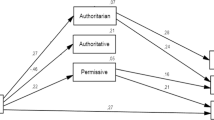Abstract
Parental reports of disagreements and serious disagreements about rules were examined in 200 families with seventh-grade boys and girls. No gender differences were found: Mothers did not report more disagreements than fathers; no more disagreements were reported for girls than boys. Disagreements about personal habits and family obligations were more common than disagreements about peer relations. Disagreements and serious disagreements, in general, were significantly correlated (positively) with parental reports of child oppositionalism and (negatively) with parents' satisfaction with parenting the target child, although some dyadic differences were found. Children's reports of parental acceptance were negatively correlated with disagreements only for the father-daughter dyad. Support was found for some of Baumrind's ([1968] “Authoritarian vs. Authoritative Control,”Adolescence 3: 255–272) notions regarding relations between rule frequency, child participation in rule making, and disagreements about rules, especially for the father-daughter dyad.
Similar content being viewed by others
References
Bakan, D. (1966).The Duality of Human Existence. Rand McNally, Chicago.
Baumrind, D. (1968). Authoritarian vs. authoritative control.Adolescence 3: 255–272.
Baumrind, D. (1975). Early socialization and adolescent competence. In Dragastin, S. E., and Elder, G. H., Jr. (eds.)Adolescence in the Life Cycle: Psychological Change and Social Context. Halsted Press, New York.
Becker, W. C. (1964). Consequences of different kinds of parental discipline. In Hoffman, M. L., and Hoffman, L. W. (eds.),Review of Child Development Research. Russell Sage Foundation, New York.
Block, J. H. (1978). Another look at sex differentiation in the socialization behaviors of mothers and fathers. In Sherman, J., and Denmark, F. (eds.)Psychology of Women: Future Directions of Research. Psychological Dimensions, New York.
Block, V. L. (1973). Conflicts of adolescents with their mothers.J. Abnorm. Soc. Psychol. 32: 193–206.
Bowerman, C. E., and Elder, G. H. (1962). The adolescent and his family. Unpublished manuscript.
Cohen, J., and Cohen, P. (1983).Applied Multiple Regression/Correlation Analysis for the Behavioral Sciences. Lawrence Erlbaum Associates, Hillsdale, NJ.
Douvan, E., and Adelson, J. (1966).The Adolescent Experience. Wiley, New York.
Duncan, O. D. (1977). A socioeconomic index for all occupations. In Reiss, A. J. Jr. (ed.),Occupations and Social Status. Arno Press, New York.
Elder, G. H. (1962). Structural variations in the child rearing relationship.Sociometry 25: 241–262.
Elder, G. H. (1963). Parental power legitimation and its effect on the adolescentSociometry 26: 50–65.
Gilligan, C. (1982).In a Different Voice: Psychological Theory and Women's Development. Harvard University Press, Cambridge, MA.
Glueck, S., and Glueck, E. (1950).Unraveling Juvenile Delinquency. Commonwealth Fund, New York.
Grotevant, H. D., and Cooper, C. R. (1985). Patterns of interaction in family relationships and the development of identity exploration in adolescence.Child Develop. 56: 415–428.
Hetherington, E. M., Stouwie, R., and Ridberg, E. H. (1971). Patterns of family interaction and child-rearing attitudes related to three dimensions of juvenile delinquency.J. Abnorm. Psychol. 77: 160–176.
Hill, J. P., Holmbeck, G. N., Marlow, L., Green, T. M., and Lynch, M. E. (1985a). Menarcheal status and parent-child relations in families of seventh-grade girls.J. Youth Adoles. 14: 301–316.
Hill, J. P., Holmbeck, G. N., Marlow, L., Green, T. M., and Lynch, M. E. (1985b). Pubertal status and parent-child relations in families of seventh-grade boys.J. Early Adoles. 5: 31–44.
Hollingshead, A. B. (1949).Elmstown's Youth. Wiley, New York.
Holmbeck, G. N. and Hill, J. P. (1986). Rules and rule-behavior in families with seventh-grade boys and girls. Unpublished manuscript.
Kandel, D., and Lesser, G. S. (1972).Youth in Two Worlds. Jossey-Bass, San Francisco.
Katz, P. (1979). The development of female identity.Sex Roles 5: 155–178.
Kohn, M. L. (1977).Class and Conformity (2nd ed.). University of Chicago Press, Chicago.
Maccoby, E. E., and Martin, J. A. (1983). Socialization in the context of the family: Parent-child interaction. In Mussen, P. H. (ed.),Handbook of Child Psychology (Vol. 4). Wiley, New York.
Martin, B. (1975). Parent-child relations. In Horowitz, F. D. (ed.),Review of Child Development Research (Vol. 4). University of Chicago Press Chicago.
McCord, W., and McCord, J. (1959).Origins of Crime: A New Evaluation of the Cambridge-Somerville Youth Study. Columbia University Press, New York.
Money, J. (1985).The Destroying Angel: Sex, Fitness, & Food in the Legacy of Degeneracy Theory, Graham Crackers, Kellogg's Corn Flakes, and American Health History. Prometheus, New York.
Montemayor, R. (1982). The relationship between parent-adolescent conflict and the amount of time adolescents spend alone and with parents and peers.Child Develop. 53: 1512–1519.
Montemayor, R. (1983). Parents and adolescents in conflict: All families some of the time and some families most of the time.J Early Adoles. 3: 83–103.
Montemayor, R. (1986). Family variation in parent-adolescent storm and stress.J. Adoles. Res. 1: 15–31.
Montemayor, R., and Hanson, E. (1985). A naturalistic view of conflict between adolescents and their parents and siblings.J Early Adoles. 5: 23–30.
Murphy, E. (1986). The onset of dating and sexual behavior in junior high school. Unpublished doctoral dissertation, Virginia Commonwealth University, Richmond, VA.
Newson, J., and Newson, E. (1968).Four Years Old in an Urban Community. Pelican Books, Harmondworth, England.
Offer, D. (1969).The Psychological World of the Teenager. Basic Books, New York.
Sorenson, R. C. (1973)Adolescent Sexuality in Contemporary America. World Publishing, New York.
Spence, J. T., and Helmreich, R. L. (1978).Masculinity and Femininity: Their Psychological Dimensions, Correlates, and Antecedents. University of Texas Press, Austin, TX.
Author information
Authors and Affiliations
Additional information
The research reported here was funded in part by Father Flanagan's Boys Home, Inc., and by a grant to the senior author from the John D. and Catherine T. MacArthur Foundation, “Family Relations in Early Adolescence.”
Received his Ph.D. in Clinical Psychology from Harvard University. Interests are the social psychology of adolescence and psychosocial adaptation to biological change.
Received his Master of Science from Virginia Commonwealth University. Interests are family relations during adolescence, sex roles and their development, pediatric psychology, and statistical applications in psychology.
Rights and permissions
About this article
Cite this article
Hill, J.P., Holmbeck, G.N. Disagreements about rules in families with seventh-grade girls and boys. J Youth Adolescence 16, 221–246 (1987). https://doi.org/10.1007/BF02139092
Issue Date:
DOI: https://doi.org/10.1007/BF02139092




